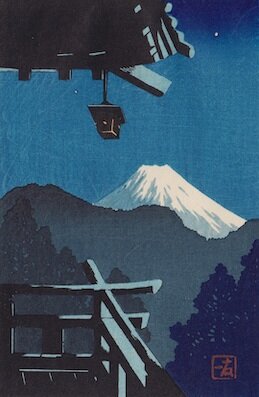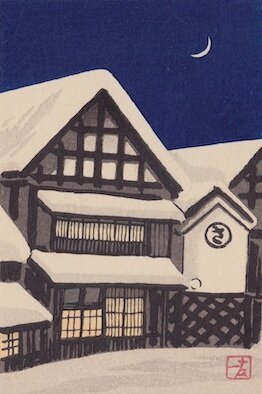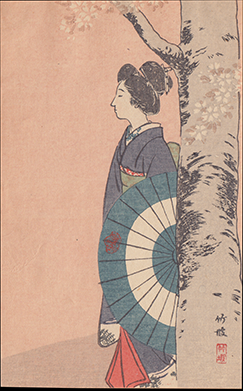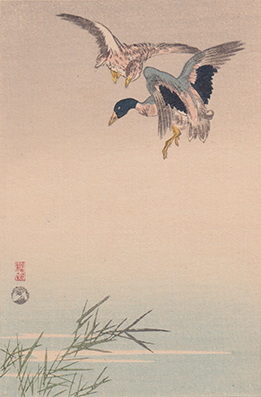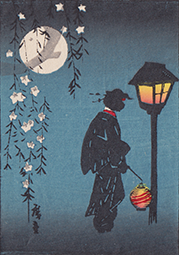Gallery 3: Shin Hanga (New Prints)
Tsuchiya Koitsu (1870-1949)
Asakusa Kannon Temple. 1950s. 9.0 x 13.8 cm
The Shin Hanga (Creative Prints) movement began in the early twentieth century as an attempt to revitalize the tradition of woodblock printed artworks which had suffered from declining interest by the Japanese at the end of the nineteenth century. Championed by the publisher Watanabe Shōzaburō, artists were engaged to provide fresh interpretations of traditional themes such as landscapes, beautiful women, kabuki actors, and birds and flowers.
Most Shin Hanga artists were trained in western styled painting and new printing techniques were perfected to capture the painterly quality of these new images. Although this is evident in many miniature prints, miniatures frequently reflect simplified production techniques compared to larger prints by the same artist. This can be attributed to both the small format and frequently ephemeral purpose of miniature prints, which were often tipped into greeting cards or affixed to postcard backs.
Shin Hanga prints rely on the traditional interaction of publisher, artist, woodblock carver, and printer. They differ from Sōsaku-hanga (creative prints) in which the artist designed, carved and printed their own works. The Shin Hanga movement is usually cited as ending around 1960.
The collection has relatively strong representation by several notable Shin Hanga artists. Examples of their work can be found in the following sub-galleries. Yumeji Takehisa is included here for his influence on the movement.
Gallery 3B: Natori Shunsen and the artists of Shin Nagao
Gallery 3M: Hasegawa Sadanobu II
The additional works in this gallery represent a number of artists who worked within the Shin Hanga movement and/or tradition. Some artists produced both Shin Hanga and Sosaku Hanga artwork. Additionally, an artist’s productivity could bridge beyond designated artistic eras. For this reason several artists are represent in more than one gallery.
Additional works by Shin Hanga artists can be found in the postcard galleries.
Fukiya Koji (1898 - 1979)
Farewell. Insert in The Ladies Graphic magazine. July, 1924. 18.8 x 13.9 cm
The prints below are from a miniature accordion book of twelve views of Kyoto (Uchida, Kyoto) by Hasegawa Sadanobu III
Prints by Kikuchi Yuichi (fl. 1950s)
Kotozuka Eiichi (1906-1979)
(Torii of the) Atago (Shrine in Winter). Published by Uchida. 1950s-1960s. 8.7 x 12
Maeda Masao (1904-1974)
1950s-1960s. 8.9 x 12.0 cm
Ōno Bakufū (1888-1976)
Bird on a Berry Branch. Undated. 8.6 x 13.5 cm
Shimizu Miezo (1893-1962)
From The Ladies Graphic Magazine. 1924. 19.0 x 11.8 cm
Attributed to Terauchi Fukutarō (1891-1964)
The prints in this section have been considered as possible works by Terauchi Fukutarō (1891-1964). The style is similar to paintings by the artist and the signature has been suggested to read Fukuta, although the artist more typically signed his name in English, at least on his paintings. Most of these prints were published by Takemura Hideo in the 1930s but lack the publisher’s seal. The last three prints in the collection bear the Takemura Hideo publisher’s seal; one print shares the same signature as those prints without the seal. The other two prints have a different signature (unread). However, the style of the prints, similarity of one of the prints to a know painting by the artist, and inclusion of the prints in a lot with prints with the artist’s more typical signature, support an attribution to the artist. A copy of the first two prints immediately below and their associated preparatory paintings from the Lavenberg Collection can be viewed here and here.
Tomoe
The six prints in this section were published by Watanabe and are sealed Tomoe. Tomoe is often considered to be a fictitious name (often referred to as a “house name”) that the publisher used for smaller variants of designs by the artists Takahashi Shotei and Kawase Hasui. As the publisher had the copyrights to the artist’s designs, it is unclear why Watanabe would produce these prints with mild variations and a different artist’s seal. However, according to David Bull, Watanabe Shiochiro has said that the name Tomoe represented Hasui playing with his name; Hasui read as single characters, is tomoe. Hasui was furthermore said to have adapted designs by Shotei and Shinsui to be printed in smaller formats under the name Tomoe.
Tokumochi Temple. After a design by Takahashi Shōtei. Undated. 8.4 x 13.5 cm
After a design by Takahashi Shōtei. Undated. 8.3 x 13.4 cm
After a design by Takahashi Shōtei. Undated. 8.4 x 13.5 cm
Peddler in the Snow. After a design by Takahashi Shotei. 1958. 8.4 x. 13.6 cm
After a design by Takahashi Shōtei. Undated. 8.4 x 13.5 cm
After a design by Kawase Hasui. Undated. 8.5 x 13.2 cm
Yamanaka Kodō (1869-1945)
Kuchi-e from New Novel (Shinshosetsu). 1914. 11.7 x 18.3 cm
Yamamoto Eishun (1879-?)
Pleading with a Beauty. Left half of a Kuchi-e (magazine insert). Undated. 14.6 x 22.2 cm
Yamamoto Tomokatsu(1927-2003)
Kiyomizu-dera Temple. Undated. 13.6 x 18.6 cm
Unidentified Artist
Pearl Divers. Affixed to a 1952 Christmas card from Mikimoto Kōkichi. 8.4 x 5.4 cm
Unidentified Artist - Izutsu Okamoto?
Print from the book Kyoto Zatsuwa authored by Takaya Shin. Published by Sakuraiya. 1936. 7.3 x 7.2 cm
Unidentified Artist
Depiction of Ryobu Torii of Itsukushima Shrine. Affixed to the envelope for a set of Christmas/New Year cards offered by the Imperial Japanese Government Railway. Late 1940s. 7.6 x 11.6 cm
Unidentified Artist
Boats Sailing on Kiso River near Nagoya Castle. 1950s. 14.8 x 10.6 cm
Unidentified Artist
Kinkakuji. 9.3 x 14.3 cm
The six prints in this section are attached to Christmas/New Year Cards. They were issued as a set of prints by the Imperial Japanese Government Railway (IJGR). This set was acquired with two additional sets of IJGR issued prints attached to cards, one set which was designed by Sekino Jun'ichirō and another that featured reproductions of Ukiyo-e images. Although all sets had already been removed from their packet envelopes, one of the packets had the date 1947 written on it which was likely the date that all sets were initially purchased. The IJGR was restructured in 1949 after which most publications simply refer to the Japanese Government Railway. Although simple in design, several of the prints incorporated special techniques such as gaufrage and lacquer printing. The artist for these particular works has yet to be identified.
The following images are from a set of eight unsigned, unsealed, woodblock prints attached to small blank cards. Although the set was described as vintage, their untoned condition suggests that these are unlikely more than 30 to 50 years old. The publisher is unknown.
The following prints depiting Ikebana arrangements are tipped onto blank notecards similar to the set directly above which were acquired at the same time. They are sealed but the artist has not been idenfitied. They likely date from the second half of the 20th century.
Cruise Ship Dinner Menu for the Powers-Mellander Grand Luxury Tour of the Pacific. A Menu from the S.S. Kamakura Maru-NYK Line (1928) in the collection of the Los Angeles Public Library has identical imagery and lists the artwork as Tea House at a Pass, attributed to Itcho Hanabusa (1652-1724). However, the right side of the image is quite similar to Takahashi Shotei’a Fuji from a resting-booth. It is a near mirror image of that print with variations in sky and details. The menu could be folded in thirds on the back and mailed like a postcard with a message inside. Although the text is obviously not woodblock printed, close examination suggests that the image was woodblock printed. 1957. 27.2 x 19.2 cm
Set of Souvenir Prints Published by Watanabe
The envelope below was reportedly acquired in or around 1958 as a gift of the Pigeon Bus Company to participants of their tours. It included four blank cards with tipped-in woodblock prints. The print below has the Kawase Hasui seal (another copy of this print can be viewed in the Hasui Gallery). The other three prints included two with designs similar to larger prints by Shotei but sealed with the “house name” Tomoe as well as a unsigned and unsealed print similar to a design by Kawase Hasui with similar proportions. These three prints can be viewed in the gallery above (dated 1958). The envelope also include a small brochure from the Watanabe Printing Co. Additional sets of souvenir prints featuring different images were also produced by Watanabe for the Pigeon Bus Company.




















































































